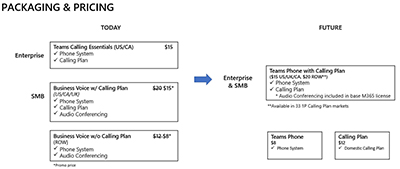Organizations that want to use Microsoft Teams for phone calls will have a new option, starting in January.
Microsoft is introducing a new product, “Teams Phone with Calling Plan.” that combines the “Microsoft 365 Business Voice” product offering with enterprise capabilities of the “Teams Calling Essentials” product. Those two products will disappear after the new Teams Phone with Calling Plan product gets released.
These product changes will simplify purchasing and bring “enterprise-grade capabilities to SMBs,”.
The overall product changes and pricing are shown in the following diagram from a Microsoft FAQ document (Word doc download):

Microsoft Business Voice Ending in March
Microsoft Business Voice is a Teams product that sets up Microsoft as an organization’s telephony service provider. It’s for Microsoft 365 and Office 365 users having “300 or fewer people,”
Microsoft is planning to phase out its Business Voice product on March 1, 2022, according to the FAQ document. However, existing Microsoft Business Voice users will be able to renew their subscriptions “until June 30, 2022” or they can choose the Teams Phone with Calling Plan option instead.
While the Teams Calling Essentials product also is going away, no dates were described by Microsoft for its end.
New Teams Phone with Calling Plan Coming Jan. 1
Organizations with Microsoft 365 and Office 365 subscriptions that include Microsoft Teams will be offered Teams Phone with Calling Plan. It’s not available yet as a standalone product.
Users of Teams Phone with Calling Plan get 3,000 minutes for domestic calls in the United States and Canada, but just 1,200 minutes for domestic calls in other markets. for Organizations that call outside their domestic zones, Microsoft sells an add-on international calling plan that offers 600 minutes per user per month,.
The calls, conducted from Microsoft Teams, work across mobile networks and the public switched telephone network.
Teams Phone with Calling Plan will be offered through Microsoft’s partners in 33 markets starting on Jan. 1, 2022.
Teams Phone with Calling Plan also will be directly available from the “Teams Phone website in the US, UK, and Canada on January 3rd, and in the remainder of markets later in January,” To add Teams Phone with Calling Plan, organizations will need to have one of the following qualifying subscriptions, per the FAQ: “Microsoft 365 Business Basic, Business Standard, Business Premium, F1, F3, E3, A3 and Office 365 F1, F3, E1, E3, A1, A3.”
Teams Phone Option and Calling Plan Option
Alternatively, organizations can buy a “standalone” product called Teams Phone, which “allows them to purchase dial tone from a third-party provider.”
Microsoft also alternatively offers a separate Calling Plan product for Microsoft 365 and Office 365 Teams users to connect to the public switched telephone network (that is, landline phones).
Audio Conferencing Realignment in March
Audio Conferencing is a Teams feature that lets users start conferences with their phones, even when the phones lack the bandwidth for a Teams session. Microsoft in August to broaden access to the Audio Conferencing beyond Microsoft 365 E5 and Office 365 E5 plans. That announcement came in the context of price hikes for Microsoft 365 and Office 365 subscriptions, expected to occur on March 1, 2022.
In its Friday announcement, Microsoft clarified that Audio Conferencing “will be available as part of all Teams-inclusive Microsoft 365 and Office 365 subscriptions starting on March 1, 2021.”


